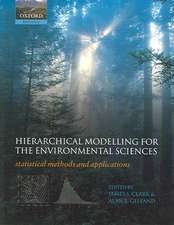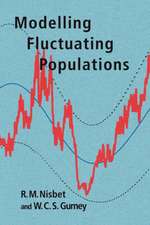Ecological Dynamics
Autor W. S. C. Gurney, R. M. Nisbeten Limba Engleză Hardback – apr 1998
The book is divided into three parts: Part I, Methodologies and Techniques, defines the authors' modeling philosophy, focusing on models rather than ecology, and introduces essential concepts for describing and analyzing dynamical systems. Part II, Individuals to Ecosystems, the core of the book, describes the formulation and analysis of models of individual organisms, populations, and ecosystems. Part III, Focus on Structure, introduces more advanced readers to models of 'structured' and spatially extended populations. Approximately 25% of the book is devoted to case studies drawn from the authors' research. Readers are guided through the many judgment calls involved in model formulation, shown the key steps in model analysis, and offered the authors' interpretation of the results. All chapters end with exercises and projects. While the book is designed to be independent of any particular computing environment, a well-tested software package (SOLVER), including programs for solution of differential and difference equations, is available via the World Wide Web at http: //www.stams.strath.ac.uk/external/solver.
Ideal for courses in modeling ecological and environmental change, Ecological Dynamics can also be used in other courses such as theoretical ecology, population ecology, mathematical biology and ecology, and quantitative ecology.
Preț: 1180.43 lei
Preț vechi: 1617.03 lei
-27% Nou
Puncte Express: 1771
Preț estimativ în valută:
225.91€ • 234.06$ • 188.53£
225.91€ • 234.06$ • 188.53£
Carte tipărită la comandă
Livrare economică 21 martie-04 aprilie
Preluare comenzi: 021 569.72.76
Specificații
ISBN-13: 9780195104431
ISBN-10: 0195104439
Pagini: 352
Ilustrații: line figures
Dimensiuni: 161 x 240 x 22 mm
Greutate: 0.6 kg
Editura: OXFORD UNIV PR
Locul publicării:New York, United States
ISBN-10: 0195104439
Pagini: 352
Ilustrații: line figures
Dimensiuni: 161 x 240 x 22 mm
Greutate: 0.6 kg
Editura: OXFORD UNIV PR
Locul publicării:New York, United States
Descriere
Ecological Dynamics is unique in that it can serve both as an introductory text in numerous ecology courses and as a resource for more advanced work. It provides a flexible introduction to ecological dynamics that is accessible to students with limited previous mathematical and computational experience, yet also offers glimpses into the state of the art in the field. The book is divided into three parts: Part I: Methodologies and Techniques defines the authors modeling philosophy, focusing on models rather than ecology, and introduces essential concepts for describing and analysing dynamical systems. Part II: Individuals to Ecosystems, the core of the book, describes the formulation and analysis of models of individual organisms, populations, and ecosystems. Part III: Focus on Structure introduces more advanced readers to models of structured andspatially extended populations. Approximately 25% of the book is devoted to case studies drawn from the authors research. Readers are guided through the many judgment calls involved in model formulation, shown the key steps in model analysis, and offered the authors' interpretation of the results. Allchapters end with exercises and projects. While the book is designed to be independent of any particular computing environment, a well-tested software package (SOLVER) including programs for solution of differential and difference equations is available via the World Wide Web at http://www.stams.strath.ac.uk/external/solver. Ideal for courses in modeling ecological and environmental change, Ecological Dynamics can also be used in other courses such as theoretical ecology, population ecology, mathematical biology and ecology, and quantitative ecology.
Recenzii
'...An excellent introduction to the mathematical models which are used to analyse changes in ecological systems over time...'
'There is now widespread agreement that it is good for students of the biologicla sciences to have some appreciation of the role that mathematics can play in their discipline...This book fits that pattern' Bulletin of mathematical Biology
'There is now widespread agreement that it is good for students of the biologicla sciences to have some appreciation of the role that mathematics can play in their discipline...This book fits that pattern' Bulletin of mathematical Biology












